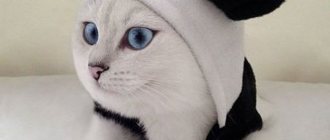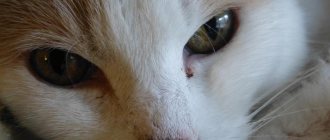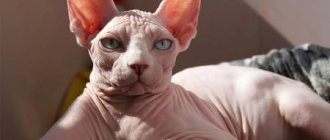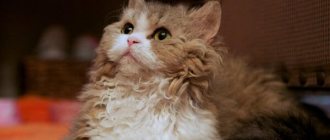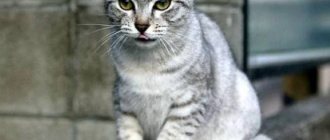Blue-eyed beauties among felines are a real gift. Most often, obstinate Siamese or Angora cats are associated with this phenotypic trait. However, they are not the only ones who can boast of a heavenly gaze. The Ojos Azules breed is also included in this list. The name of the breeding group was given precisely because of the coloring of the eyes. After all, ojos azules is translated from Spanish as “blue.” But, fortunately, this is not the only advantage of fluffy cats and kittens.
Origin story
Translated from Spanish, “ojos azules” means “blue eyes.”
It is surprising that cats of this breed always have sky-blue eyes, but there are no Siamese or Angora cats in their family. Then where does such a miracle come from? The story begins in the last century in the American state of New Mexico. A married couple has an ordinary-looking cat: with a familiar tortoiseshell color, a clever hunter and an affectionate purr.
However, the eyes (like the eyes of all her kittens without exception) were noticeably different from the eyes of the neighbor's cats: they were bright blue. The cat owner generously distributed kittens to everyone. This is how they got to Europe.
In 1984, blue-eyed cats became of interest to felinologists. Genetic studies have proven that the reason is a unique DNA gene that is passed on from generation to generation.
The breed was recognized in 1991, and it was officially stated that there are only 10 individuals of Ojos Azules in the world! In fact, there were, naturally, much more of them. But the dispersion of animals throughout the globe did not allow for a more accurate count.
Characteristics of Ojos Azules
The main psychological traits of attractive pets are a balanced temperament and a peaceful nature. Animals prefer peace and quiet to a greater extent. That is why it is not recommended to have a cat of this breed in families with many hyperactive children. The best conditions for keeping Ojos Azules can be created if you keep them constantly in a warm apartment. But, despite their love for a quiet life, kittens and young cats don’t mind playing with people.
They are very affectionate and friendly towards new people in the house. Sociability and at the same time love for the owner are perfectly combined in the character of the Ojos. At the same time, cats are very tactful: if a person is busy and does not give a signal to communicate, the pet will not get bored and demand attention to itself. Blue-eyed cats adapt to new conditions very easily, so they can withstand any move or change of environment stoically without signs of panic or anxiety. But at the same time, animals perceive the long-term absence of the owner who cares for them painfully, even to the point of depression. If a person is forced to constantly be on business trips, then before getting a cornflower-eyed miracle, he should think carefully about whether such a breed will suit his living conditions.
Ojos Azules cats have a high level of intelligence. They are receptive to learning and mastering new simple tricks. A quick mind allows pets to adequately accept the rules dictated by the owner, for example, not to damage upholstered furniture, only go to the litter box, and not to climb on tables.
Standards
Cats of the Ojos Azules breed are of medium size and the same weight. Females are slightly smaller than males and weigh 3-4 kg, males rarely exceed the 5 kg threshold. They are flexible and dexterous, proportionally built and very graceful.
| Standard | Description |
| Head | In the shape of a triangle, with clearly defined cheekbones and a neat chin. |
| Ears | Small, erect, with rounded tips. |
| Eyes | Almond-shaped, slightly slanting. According to the standard, there can be 24 shades of the iris, but individuals with so-called heterochromia are also often found: when one eye is blue and the other is green or yellow. |
| Torso | Strong, elongated, with a wide chest and raised croup. |
| Limbs | Slender and long, the hind legs are slightly longer than the front ones. |
| Tail | Medium length, thin, its tip is rounded. |
| Wool | It feels very soft and smooth, shiny. Can be long or short. There is practically no undercoat. |
For a cat of the Ojos Azules breed, you will have to pay a tidy sum. Animals of the pet class - with a disadvantage that does not allow them to participate in exhibitions - cost about 30-50 thousand rubles. An individual of the breed class (heterochrome or latent) costs from 50 to 70 thousand rubles, and an individual of the show class, which is ready to participate in exhibition events, costs at least 70 thousand rubles. Currently, such a kitten can only be purchased in a nursery. There are no such nurseries in Russia, as well as in the CIS countries, since this breed is not so popular in our part of the world. But in the USA there are many of them. Are you ready to go on such a long journey?
Reviews from Ojos Azules owners
You can leave your reviews about the Ojos Azules cat breed, other users will be interested in: Marianna, Moscow
“I received my cat Martin as a gift from my American relatives. If there were Ojos Azules nurseries in Russia, I would buy another one without hesitation! Every time you come home from work, to see him greeting you at the doorstep, those amazing blue eyes on his funny face - it’s just happiness! Every time I am moved to tears when he stretches out his paws to me and presses his cheek to my cheek.”
Svetlana, Ryazan
“I was visiting a friend in the States and met her cat. Kindest creation! She is friends with a rabbit and two rats, accompanies her friend on her morning jog, and takes care of her main owner, Danny, who recently turned one year old. She was polite and nice to me, although she seemed a little prim, like an old Quaker woman. If it weren't for the price, I would have returned home with an equally cute cat. In the meantime, I’m saving money, looking at photos on the Internet and dreaming.”
Colors
The list of colors allowed by the standard is long. There are only 3 exceptions:
- Himalayan color.
- Mixed race color.
- White spots (allowed only if the cat’s tail tip is also white, and there are no complaints about all other qualities).
In the photo there are cats of the Ojos Azules breed of popular colors: red, black, gray
Character and behavior
Ojos Azules cats are affectionately called Ojos. These blue-eyed creatures have an excellent character: they are kind, quickly become attached to their owners, and do not show aggression if offended.
The human environment for Ojos is the best company, and their beloved owner (whom they choose immediately upon entering the house) is the best friend in the world, to whom cats will give all their love and affection. It is impossible to quarrel with them: okhs know how to listen and obey, and they carry out commands quickly and willingly, without forcing them to raise their voice.
Both adult cats and children are distinguished by rare cleanliness. From birth, mothers teach their babies to carefully monitor the cleanliness of their skin and paws, the length of their claws, and even the freshness of the litter in the toilet (read when kittens start going to the toilet).
Don’t be surprised if your four-legged toddler takes you to his litter box with a heart-rending squeak: he just wants to show you that it’s time to tidy up there. And if his call remains unheard, the baby will endure as long as he can, and then do his business in some secluded place.
A balanced and peaceful character is what is especially valued in these cats. They don’t mind playing and running at all, but in moderation. And after playing, the cat needs to rest in a secluded corner, where she can catch her breath and think in peace and quiet. A feeling of security is what they need. It will be just ideal if you can equip your pet with such a corner of the house by buying a cozy soft house with a roof or making a separate play complex with ladders, climbing pipes and a shelter at the very top.
A cat needs such rest - alone - so if the children in your family are hyperactive, you should not get this breed.
The goodwill of the Azules extends to all those people who come to your home. The cat will not run and hide, or shy away from strangers’ hands and voices, no. She will come out decorously to say hello, sniff the stranger and may even accept a treat from him, but all this is only with your permission. If the azules senses that the guest is unpleasant to the owner, she will not play next to him even for a full bowl of meat.
The ability to subtly feel and recognize mood is another quality of Ojos Azules. They will not intrude, having noticed a reluctance on your (or the other) side to communicate, but they will sit nearby and, after watching, will definitely seize the right moment and cuddle.
They do not tolerate loneliness, and in general, your long absences will not please them. If your work involves constant travel and absences from home, think about: is it worth torturing an animal like this? There are other cat breeds that don't need human company as much.
Ojos azules are very smart and can easily be taught a few tricks. In any case, they will do with great pleasure, giving their paw and sitting down on command. But more difficult tricks - for example, jumping through a hoop - may not be possible right away. And here you will need patience and gentleness. If you scare an Azules, he will become very upset and will avoid you for a while.
Ocho always tries to find a common language with other animals. But if he encounters aggression, he will stay away from the enemy.
Expert opinion
Dusheba Vera Ivanovna
In 2010, she graduated from the Moscow State Academy of Veterinary Medicine named after K.I. Scriabin with honors, specializing in veterinary medicine. I regularly attend veterinary conferences, congresses, and webinars.
The Ojos Azules are practically unable to fight back. They do not sense danger well, or rather, they do not expect a trick, which excludes free range and requires special supervision on your part.
Ojos do not like open areas, so they sit in a carrier or bag for the required time without whims. They are also quite favorable towards automobiles and other transport: they rarely get motion sickness, and they don’t know how to make scandals.
Do not buy a kitten without seeing it in person and talking to the breeder. Be sure to look at the pedigree: a purebred individual must have ancestors up to the 3rd (inclusive) generation indicated in the document. Choose a strong baby, with clean ears and eyes, active, and not afraid of human hands and voices. Remember: a breeder who cares about his pets will not sell a kitten under 3 months old. There are several reasons for this: firstly, the baby needs its mother, her milk and care, and secondly, the breeder is always responsible for the first vaccinations.
Cat health
The Ojos kitten is born not burdened with dangerous hereditary diseases. It is only important that both his parents are not blue-eyed. Otherwise, the descendant may receive a whole set of genetic abnormalities. This danger must be taken into account when crossing pets.
The owner should also know that, unlike other breeds of blue-eyed cats, Ojos do not have hearing problems. Vaccinations done on time at an early age will help strengthen your pet’s immunity. Healthy individuals live on average 10-15 years.
Care instructions
Wool
The coat of Ojos Azules requires careful care, regardless of whether it is long or short. But, since it does not fall into tangles and does not have a dense undercoat, there is no need to put a lot of effort into combing.
Buy a slicker brush, a brush with rubber bristles and a furminator. First, comb the cat with a slicker brush, then remove any remaining hair with a rubber brush. Use the Furminator once a week when the cat is shedding, and 2 times a month when the shedding period is over.
If you don't brush your cat, he will swallow fur when he washes himself. In the stomach, the wool rolls into clumps. To get rid of them, the wild cat eats special grass. At home, you will have to grow this grass yourself. It's not difficult: buy oat seeds at the pet store and plant them in a convenient container. When the animal wants to “flush” its stomach, it will come to her. However, you can give your cat a special paste for removing hair.
Bathing
Azules do not like to bathe, so wash your cat in the bathroom 2-3 times a year (if she regularly walks outside, more often). Do not use human gels, but special cat shampoos (without dyes, fragrances and other harmful ingredients).
Does your cat like to swim?
Not really
Claws
Azules will clean his claws himself; just install a scratching post in your apartment and show it to your baby.
Ears and teeth
But he is unlikely to cope with cleaning his ears and teeth. Help him: remove wax from his ears every week, and plaque from his teeth - 2 times a month. To care for your ears, you will need a cotton swab dipped in ear lotion or boiled water, and for your teeth, a special cat paste (without fluoride or additives) and a soft small brush.
Eyes
Azules' eyes don't run. If discharge appears, you need to take your pet to the doctor.
Care and maintenance of Ojos Azules cats
New Mexico natives do not require special care. This is a huge advantage over cats of other purebred lines. All that is required for the normal life support of a pet is a classic set of procedures:
- high-quality balanced nutrition;
- vitamins in autumn and spring;
- combing fur during active shedding;
- implementation of the mandatory vaccination program;
- hygiene procedures (cleaning ears, bathing);
- prevention against helminths;
- prevention against skin parasites.
Catering
Ojos have a strong stomach, so they cope well with both industrial food and natural food.
Natural products
With a natural menu, everything is more complicated: here you need to calculate not only the amount of proteins, fats and carbohydrates, but also select quality products.
If you have the opportunity to order farm products, great. However, you can also buy good food in regular markets. But it is important to remember the following:
- Cats should not eat fatty or rotten meat. Pork, lamb, duck and goose meat are too heavy to digest, in addition, it is this meat that most often contains parasites. Buy fresh beef, chicken, turkey, rabbit or lamb, freeze it in the freezer for 2-3 days, and pour boiling water over it before feeding: this will be enough to destroy parasites and their eggs. You can also boil meat, but feed your cat not pure meat, but mixing it with porridge (barley, rice, buckwheat, oatmeal) and stewed vegetables (carrots, pumpkin, broccoli, spinach, herbs). Crumble boiled chicken yolk into the porridge 1-2 times a week.
- Offal is not a replacement for meat, but a supplement. Boiled liver, raw ground necks and kidneys, hearts and ventricles can be given 2-3 times a week.
- Fish is more of a delicacy than a complete meal. Moreover, the delicacy is dangerous: if you give your cat fish more than once a week, with age she will develop kidney problems. Choose low-fat fish: pollock, trout, flounder, salmon, hake, halibut.
- Many cats love fermented milk products (yogurt, sour cream, cottage cheese, cheeses), but you cannot feed them from your table. Buy only natural yogurt, without additives, unsalted and hard cheese, low-fat cottage cheese.
- It is necessary to add vegetable oil (sunflower, olive, flaxseed: half a teaspoon) and a vitamin and mineral supplement, as well as dry yeast to the food.
Water - clean and warm - should be available to cats at all times. Do not feed your cat tap water: it contains too many substances harmful to the animal. Settle tap water or run it through a kitchen filter.
It is prohibited to give:
- Bones, fat;
- Legumes, potatoes, tomatoes;
- Sweet, flour, salty, sour, pepper, pickled;
- Alcohol, coffee, tea, juices;
- Seasonings, spices, mayonnaise, sauces;
- Human vitamins;
- Dog food.
Recommended food
Industrial food is often chosen by busy people who are not ready to spend time on cooking. Modern feeds are able to completely meet the animal’s need for all essential vitamins and minerals.
But choose your food carefully: behind active advertising, most often there is a useless dummy.
Economy food: Darling, Felix, Friskies.
Premium food: Schesir, Trainer, ZooRing.
Super premium food: Brit Care, Summit, Optimal.
Holistic food: Acana, Carnilove, Farmina N&D.
Below are recommended premium, super-premium and holistic foods. Links with the names of the food are clickable, on them you can, within our website, get acquainted with the descriptions of the food and read reviews from owners of cats of the Ojos Azules breed.
| Premium | Super premium | Holistic |
| Science Plan | Brooksfield | Grandorf |
Diseases
With good care, these cats can live 12-15 years. Surprisingly, these cats have virtually no “specific” (breed) diseases. However, it happens that when healthy parents are brought together, non-viable kittens are born.
Congenital deformation of the skull causes death in babies. It is important to remember the following: you cannot cross two blue-eyed Ojos Azules.
The second partner may be heterochromic, of a different breed, or even outbred: the “blue eyes” gene is dominant. But it is best to find a cat with bluer eyes of the same breed.
These cats, like all others, need vaccinations and deworming. The first vaccination is given at 9-12 weeks (against calcivirosis, rhinotracheitis, rabies, chlamydia), then revaccination is carried out every year. Injections do not guarantee that your pet will not get sick, but it will significantly reduce the risk of getting sick and will allow you to endure the disease much easier and survive.
Exterior Features of Cats
Representatives of the blue-eyed cat family usually have a proportional and not too massive body. The animal's chest is powerful and wide. These cats have well-developed muscles and natural flexibility. They usually weigh no more than 5 kilograms.
There is a sense of elegance and grace in the gait of Ojos Azules. The croup is set slightly higher than the withers. Cats of this breed can be long-haired or have short hair.
A distinctive feature of Ojos Azules is their almond-shaped, cornflower blue eyes. Moreover, nature has rewarded these cats with a wealth of shades of blue: there are at least 24 of them. Cases of multi-colored irises of Ojos Azules cannot be ruled out.
The fur of these cats is soft to the touch, the undercoat is not very well developed. A special feature of blue-eyed fluffies can be considered the pleasant shine of their hair.
According to the developed breed standards, a representative of Ojos Azules must meet the following parameters:
- The head is triangular in shape, which favorably emphasizes the well-defined contours of beautiful eyes. The muzzle is small, the whisker pads are angular. The neck is arched. The cheekbones protrude slightly forward. If you look at the animal from the side, you will notice a small indentation in the area of the transition to the nose. The chin is strong and not too prominent.
- The eyes are expressive, widely spaced, and shaped like large almonds. The color is like that of Siamese cats, rich blue or with an admixture of gray. Green pigment is not allowed. Heterochromia is possible provided that one eye is certainly blue, and the other is greenish or yellowish.
- The paws are proportional to the body; The forelimbs are slightly shorter than the hind limbs.
- The ears are small, with slightly rounded tips, set wide and high.
- The fur is silky with iridescence, the hairs are thin and soft, adjacent to the cat's body.
- Any color is allowed, with the exception of Himalayan and white. White “islands” on a cat’s fur are not welcome if the tip of the tail is not colored the same color. Similar pigmentation on the chest and abdomen of Ojos Azules is considered a significant deviation from the standard.
- The length of the tail is commensurate with the cat's body, gradually narrowing and sharpening towards the tip, which must be white.
When showing blue-eyed pets at various exhibitions, owners may face disqualification. The reasons for this decision are the following identified flaws in the pet:
- eye color is not blue;
- variegated color;
- the tip of the tail is not white;
- removed claws;
- deafness.
